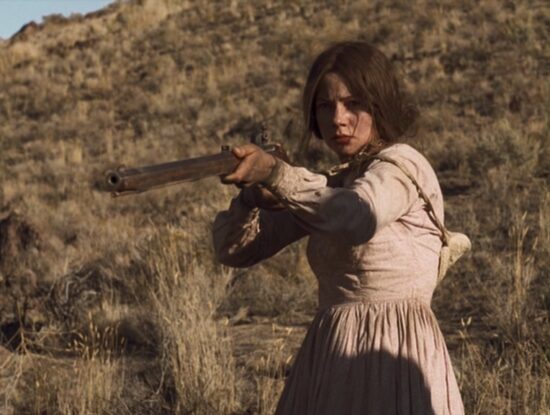
A film is as good as the sum of its crafts, crafts that must seamlessly wove the threads that spun the illusion that is the story we watch so earnestly. That is why I find that it is fascinating to talk about a film from the point of view of each craft, such as costume design, because it opens up wider ways of interpretation of and interconnectivity with the film.
Kelly Reichardt has carved out a distinctive universe with her films, especially her westerns. It is a different kind of West that her characters are part of, a West they do not conquest, maybe do not even inhabit, but survive: quiet, spare, rendered through a visual naturalism and a realistic, subdued approach, but with more provocative messages running underneath. In Meek’s Cutoff (2010), the director builds drama with endless landscapes and endless days and an endless journey and characters gradually lost in front of the wilderness. Watching the film, you get the grip of the reality of the wagon trains going West, and of so many broken American dreams – there’s nothing spare in that. The landscape is so vast, but the characters’ world is so confined that you come to inhabit their world, aware of every single sound and fact about their everyday life, about their moves, about their manners, about their clothes.
Their clothes in fact are so much part of the story, every little detail sewn into the characters, that I reached out to the costume designer, Vicki Farrell, to talk at length about the costumes for the film. We have touched on other films as well, from the realistic contemporary design for Night Moves (2013), to cross-dressing Hilary Swank in Boys Don’t Cry (1999) and the colourful costumes made in-house for the television series At Home with Amy Sedaris. An incursion into the very many universes that a costume designer’s work is paramount in creating.
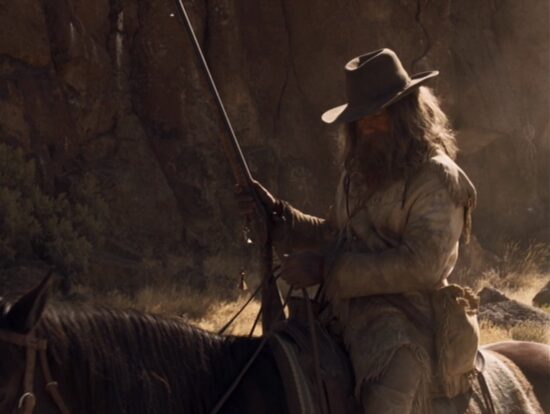
Meek’s Cutoff is at its 10th anniversary this year. It is a world so beautifully and skillfully crafted in a certain period of time and place that, regardless of the decade when you are watching it, it simply draws you in, reminding us once more that cinema is primarily visual. The hooded sun bonnets the women wear, for example, hide their faces, casting deep shadows, and it’s hard for the viewer to see into them, the face of the women wearing them, and I expect this is a very accurate depiction of 1845, when the action takes place, that these hooded sun bonnets were meant to serve their purpose. Clothes that speak about the character, the story, and which are not concerned to make visible the actress wearing them. How rigorous was the historical research you underwent for the film and what was the most challenging part for you, as a costume designer?
So happy to start with Meek’s Cutoff! Wow… 10 years. I have such strong memories of that shoot. Kelly Reichardt and Chris Blauvelt are two of my favourite people. Meek’s was my first time working with Kelly and also the film that brought Chris Blauvelt into Kelly’s world. I clearly remember his first day (night!) on set.
I loved working with Kelly. She plans out her films, her locations, almost a year before production and shooting begins. I was exchanging research and sending fabric swatches to Kelly as she was scouting locations and she was sending me pictures of the fabrics in the actual locations in the eastern Oregon high desert. It’s not usual that I get to design the costumes so early in the process of working out the design of the film. In my experience, the costume designer is mostly hired and starts working and designing just a month or so before shooting starts.
I did lots of research on fabrics and colours and natural dyes and men’s and women’s and children’s everyday clothing in the time of the American settler’s journey west. Bonnets!!! Hmm … Yes, there was some discussion and concern about hiding actors faces. I wanted to make historically accurate bonnets that have very large brims to protect the wearer from the sun and dust. Kelly wanted this, too, and her producers were behind her, so in the end I wasn’t asked to shorten the brims. I sewed all three bonnets myself by hand. I knew Kelly was going to do some lingering close-ups and there weren’t machines for sewing around in the 1840s. I think having the pioneer women’s face covered makes you more able to see them, to look at them, to be aware of their reactions and their movements. There was so much hand work on the production. Our production designer Dave Doernberg and I were always proudly comparing our calloused and ragged working hands.
I think it’s important that you mention Chris Blauvelt, because the cinematography is a huge part of the costumes’ success in a film, as of course is every artistic department input, but I mention cinematography because how the DP (director of photography) shoots a film, using certain angles, or only shooting from the bust up, weighs heavily on the look of the film and on how a costume designer must focus on the clothes and on what exactly they want to be seen. Have there been times when you had to adapt to a certain style of filming?
There’s always the possibility on set of an unplanned close-up of shoes or a sleeve or another costume detail. I’ve learned not to trust the shot list one hundred percent and be prepared with every detail in place for when impromptu inspiration strikes. Also, it’s good to have backup options in case a costume doesn’t work for some reason once in the location. That has happened to me, but it has been mostly because the sound person couldn’t get clean sound quality with certain types of fabric and the body mics. In fact that happened in Night Moves. I had to give Dakota Fanning my own cotton jacket to wear in one scene of the film as we were ready to shoot and far from the costume trailer.
I’ve worked with some DPs and directors that have some colour restrictions or colour preferences and that design decision is worked out in the planning of the film.
The natural-light cinematography of Christopher Blauvelt envisages the film in sepia tones and the muted colour palette of the clothes, except for Meek’s red shirt, blends right in. Was that intentional or did people dress like that in those days?
I spent a lot of time in my kitchen testing out the aging and fading of the fabrics. The pink of the dress that Mrs. Tetherow (ed. note: Michelle Williams’ character) wears started as a stronger, more reddish colour. Another popular colour for a younger lady’s calico dress at the time was called cheddar cheese. That bleached and faded to a most beautiful golden shade. Early natural dyes wouldn’t have held up as strong colours in the sun and dust of the pioneers’ journey. That’s how the palette of the costumes became dusty and faded.
Meek wears red because he is that person that needs to be paid attention to. Red flannel shirts were popular and that red is close to the madder dyed red of the time.
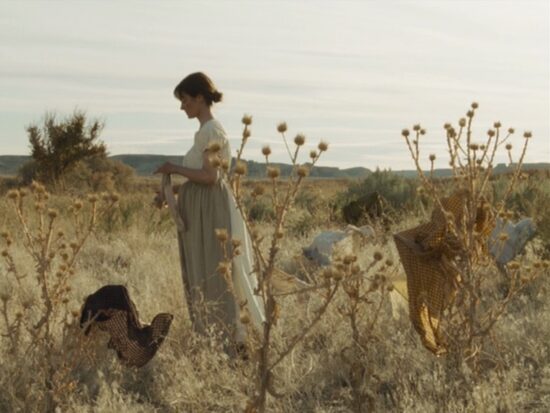
Is that why Zoe Kazan’s character (Millie Gately) is wearing a yellow calico dress? She is the youngest female character.
Yes! That’s right. I chose that colour for Mrs. Gately because it said something about her age and her personality. A lot of the actual settlers that went west were young married couples. Teenagers.
All men wear hats, but Bruce Greenwood’s (Meek’s) seems to sit differently on him, it’s concealing, along with its long hair and beard. What story do his clothes tell?
Meek is a character playing out the role of being himself. That’s why his hat, his beard, his hair, his red shirt and his buckskin suit are all a little larger than life. At one point in the film, he was supposed to appear by the campfire in a gentleman’s smoking turban. I was sort of against it at the time, because I thought it was too much, but now I wish it was in there. Meek could have pulled off a costume shenanigan like that!
Do you believe that costumes not only relate to the characters who wear them, but also to the modern audiences who watch them? Is that why you didn’t reproduce an exact replica of Meek’s headpiece? And does it take a lot of convincing for the director to accept a different approach that the costume designer proposes?
I was concerned the turban might have looked too comical in the film. That turban may not have even been Meek’s own. It may have been a prop in the Victorian studio when the portrait was taken many years after the time of Meek’s misguidance of the Oregon settlers.
There can be constant adjustments to the costumes as the project evolves. Lots of things influence the final look of the film’s costumes. The costume design has to bend and grow along with the character and the actor playing the character and the script changes and the director’s changing vision and even the locations as the film comes together. But I always have a strong design base early on to keep referring to and to keep the costumes true.
Do you usually talk about the costumes with a director or is it more a conversation about characters and their evolution?
My favourite films have been the ones where there was a lot of conversation early on with the director. Getting excited about exchanging reference pictures and paintings and even sharing written references. For instance, Kelly and I read the settler women’s journals of the western journey and there was a lot about their everyday life and workaday routines that influenced the way the costumes looked.
Are the opening and ending film credits really sewn on a piece of cloth?
Yes!! Not only are they embroidered on cloth, but it is the actual canvas cloth that was covering the Tetherow’s covered wagon. The artist Marlene McCarty created the Meek’s title artwork and we both hand embroidered the title cards. The idea came from a picture I found while researching the pioneers of an example of an embroidery by a pioneer woman with a family portrait and the words “A Piece of the Old Tent”. She had embroidered an old piece of canvas and it was a memory of her journey west with her family as a young woman. The original embroidery was kind of offset, crooked and imperfect and seemed heartfelt.
How often does the work of a costume designer call for this kind of craftsmanship and attention to detail these days?
The hands-on experience of making Meek’s Cutoff was very special and not usual.
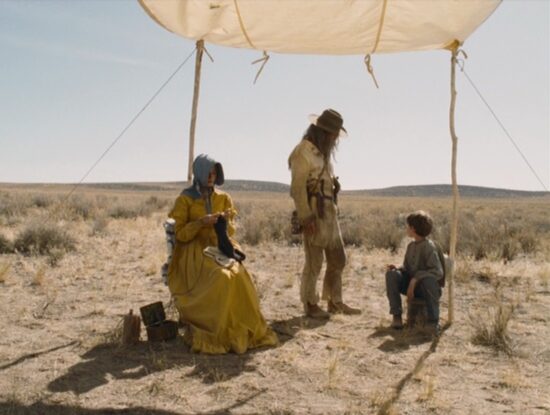

Night Moves was your next film with Kelly Reichardt. Does working on a contemporary film differ radically from period films, from the costume designer’s point of view? How did you approach costuming the characters in Night Moves?
To me, designing a contemporary film is more difficult than a period film. You don’t get the control of designing the costumes, choosing fabrics and fine-tuning colours. For contemporary films, I am mostly finding the costumes, shopping for them, instead of making them or having them made. I still like to have a lot of research compiled and try to find what the real people who are like these characters wear. I like to keep things true and realistic if that’s what the film calls for. In Night Moves, I felt the main characters would like it if all people just disappeared back into the earth. The way that Josh, Dena and Harmon dressed was the opposite of standing out.
But I also think that contemporary costume design may not often be acknowledged as it should be and that the audience can easily overlook the fact that in a good movie, nothing is left to chance, not even a plain t-shirt or an hooded jacket.
I agree!! Finding the right t-shirt or hoody or jeans can be a lot of trouble! My stockpile of costumes consists of lots of vintage basics like sweatshirts and t-shirts and jeans and belts. The basics are the most useful costume items that I collect. People think that, as a costume designer, I must have the coolest collection of vintage costumes, and I do, but what I really value and what I use the most from my stock are nicely aged basic clothing items like jeans and sweatshirts.
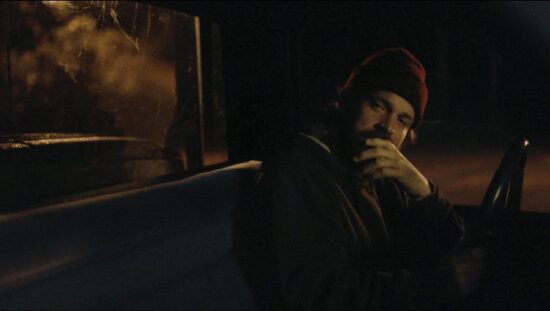
Speaking of jeans and sweatshirts, I would like to talk a little about Boys Don’t Cry. In cross-dressing narrative, the relationship between clothing and body plays an even more crucial part in forming an identity and in establishing how the character is looked at by the other characters and by the audience. What was the starting point in dressing Hilary Swank’s character, Brandon Teena?
I watched the documentary The Brandon Teena Story many times. At the NY Public Library (before looking things up on the internet was the norm!!), I researched the places where Brandon Teena lived, Lincoln, Nebraska and Falls City, Nebraska, and the time, the early 90s. Thought about what it would be like to be a young person then. What music would you be into, where would you hang out, where would you buy your clothes and how would you create your look.
We prepped and filmed Boys Don’t Cry in 1998 in Dallas, Texas, which is not that far from Nebraska and only 5 years after the murder of Brandon Teena. I thrifted most of the costumes in used clothing stores in the outskirts of Dallas and it really seemed like I could find actual clothing from that place and time.
I had two fittings with Hilary to figure out which types of clothing worked best to help her pass as a young man. So the costumes would disguise her figure, but not be too baggy and loose which could make Brandon look as if he was playing dress-up. Also, what the best method of binding her body would be for Hilary’s comfort. I had a binding vest that was made for that purpose, but it was too tight and uncomfortable and not working. What ended up working best was wrapping Hilary with athletic bandages.
I remember reading that director Kimberly Peirce was very specific in not wanting anyone meet Hilary Swank (who was at her first major role in this film) as Hilary and wanted her to pass as a boy everywhere as much as she could. Was there any specific part you played in this, in not only helping the character, but also the actor playing the character, get into this other identity offset?
I didn’t really have any part in the character preparation that Kimberly and Hilary did offset. I think that happened in NY and LA before everyone came to Dallas for the shoot. But during the shoot all the cast and crew stayed in the same hotel in Dallas and I think that really helped with pulling everything together. We could all meet up and exchange our ideas and our work and really create the film as a group.
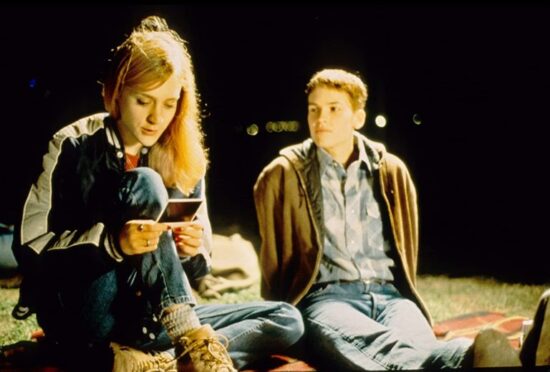
We’ve only talked about main characters. How are you addressing dressing the extras? Because it’s so crucial that they feel that they are part of the world that you are creating.
I agree one hundred percent that the background players are so important to the look of the film. I prefer to have fittings with the extras ahead of shooting if I can. I would like to always have a specific department that just focuses on getting the background costumes right. You can get so many interesting details in there! I’m always checking out what everybody’s wearing in the fringes of films.
You have also worked for television. Does costume designing for television differ much from designing for the big screen, especially today when the bar has been set pretty high for television with so many interesting new series?
I know! So many great things to watch! For me, the difference is that in designing for a TV/Web series you have the luxury of more money and more crew to work with. I just finished the 3rd season of a comedy series called At Home With Amy Sedaris this February. It’s a super fun show with most of the costumes designed and made in-house. Lots of crafty colourful costuming and flashy sets. Very different from the realism of Meek’s Cutoff and Boys Don’t Cry!
Website: vickifarrell.net
This piece is published courtesy of classiq.me
All film stills courtesy of Evenstar Films, Film Science, Harmony Productions (Meek’s Cutoff) / Cinedigm Entertainment Group (Night Moves) / Fox Searchlight Pictures (Boys Don’t Cry)
